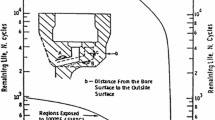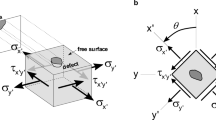Abstract
Mechanics issues related to the formation and growth of cracks ranging from subgrain dimension to up to the order of one mm are considered under high cycle fatigue (HCF) conditions for metallic materials. Further efforts to improve the accuracy of life estimation in the HCF regime must consider various factors that are not presently addressed by traditional linear elastic fracture mechanics (LEFM) approaches, nor by conventional HCF design tools such as the S-N curve, modified Goodman diagram and fatigue limit. A fundamental consideration is that a threshold level for ΔK for small/short cracks may be considerably lower than that for long cracks, leading to non-conservative life predictions using the traditional LEFM approach.
Extension of damage tolerance concepts to lower length scales and small cracks relies critically on deeper understanding of (a) small crack behavior including interactions with microstructure, (b) heterogeneity and anisotropy of cyclic slip processes associated with the orientation distribution of grains, and (c) development of reliable small crack monitoring techniques. The basic technology is not yet sufficiently advanced in any of these areas to implement damage tolerant design for HCF. The lack of consistency of existing crack initiation and fracture mechanics approaches for HCF leads to significant reservations concerning application of existing technology to damage tolerant design of aircraft gas turbine engines, for example. The intent of this paper is to focus on various aspects of the propagation of small cracks which merit further research to enhance the accuracy of HCF life prediction. Predominant concern will rest with polycrystalline metals, and most of the issues pertain to wide classes of alloys.
Similar content being viewed by others
References
P.C. Paris, M.P. Gomez and W.P. Anderson, A rational analytic theory of fatigue, The Trend in Engineering 13 (1961) 9–14.
L.F. Coffin, A study of effects of cyclic thermal stresses on a ductile metal, Transactions ASME 76 (1954) 931–950.
S.S. Manson, Behavior of Materials Under Conditions of Thermal Stress, NACA Report No. 1170, Lewis Flight Propulsion Laboratory, Cleveland (1954).
D.F. Socie, Estimating Fatigue Crack Initiation and Propagation Lives in Notched Plates Under Variable Loading Histories, T.&A.M. Report No. 417, University of Illinois (1977).
N.E. Dowling, Fatigue at notches and the local strain and fracture mechanics approaches, Fracture Mechanics, ASTM STP 677, C.W. Smith (ed.), ASTM Philadelphia (1979) 247–273.
D.F. Socie, M.R. Mitchell and E.M. Caulfield, Fundamentals of modern Fatigue Analysis, Fracture Control Program Report No. 26, University of Illinois, Urbana (April 1977).
P.J.E. Forsyth, A Two-Stage Process of Fatigue Crack Growth, Proceeding, Symposium on Crack Propagation, Cranfield (1971) 76–94.
K.J. Miller, Metal fatigue—past, current and future, Proceedings, Institute of Mechanical Engineers 205 (1991) 1–14.
K.J. Miller, Materials science perspective of metal fatigue resistance, Materials Science Technology 9 (1993) 453–462.
R.C. McClung, K.S. Chan, S.J. Hudak, Jr. and D.L. Davidson, Analysis of Small Crack Behavior for Airframe Applications, FAA/NASA International Symposium on Advanced Structural Integrity Methods for Airframe Durability and Damage Tolerance, Hampton, VA, May 4–6, NASA CP 3274, Part 1 (1994) 463–479.
K. Yamada, M. Shimizu and T. Kunio, Threshold behavior of small cracks in dual phase microstructures, Current Research on Fatigue Cracks, T. Tanaka, M. Jono and K. Komai (eds.), Current Japanese Materials Research, Elsevier, 1 (1987) 27–40.
K. Tokaji, T. Ogawa, Y. Harada and Z. Ando, Limitations of linear elastic fracture mechanics in respect of small fatigue cracks and microstructure, Fatigue and Fracture of Engineering Materials and Structures 9(1) (1986) 1–14.
S. Suresh, Fatigue of Materials, Cambridge Solid State Science Series, Cambridge University Press (1991).
G. Venkataraman, T. Chung, Y. Nakasone and T. Mura, Free-energy formulation of fatigue crack initiation along persistent slip bands: calculation of S-N curves and crack depths, Acta Metallurgica Materialia 38(1) (1990) 31–40.
G. Venkataraman, Y. Chung, and T. Mura, Application of minimum energy formalism in a multiple slip band model for fatigue, Parts I & II, Acta Metallurgica Materialia 39(11) (1991) 2621–2638.
K. Tanaka and Y. Akiniwa, Propagation and non-propagation of small fatigue cracks, in Advances in Fracture Research, Proceedings ICF7, Vol. 2, Houston, TX, (March 20–24 1989) 869–887.
Y.H. Zhang and L. Edwards, The effect of grain boundaries on the development of plastic deformation ahead of small fatigue cracks, Script Metalallurgica Materialia 26 (1992) 1901–1906.
K. Tanaka, Short-crack fracture mechanics in fatigue conditions, Current Research on Fatigue Cracks, T. Tanaka, M. Jono and K. Komai (eds.), Current Japanese Materials Research, Elsevier, 1 (1987) 93–117.
A. Navarro and E.R.de los Rios, An alternative model of the blocking of dislocations at grain boundaries, Philosophical Magazine 57 (1988) 37–50.
K. Dang-Van, Macro-Micro Approach in high-cycle multiaxial fatigue, Advances in Multiaxial Fatigue, ASTM STP 1191, D.L. McDowell and R. Ellis (eds.), ASTM, Philadelphia (1993) 120–130.
J. Tong, J.R. Yates and M.W. Brown, A model for sliding mode crack closure: Parts I & II. Engineering Fracture Mechanics 52(4) (1995) 599–623.
J.C. NewmanJr., A crack closure model for predicting fatigue crack growth under aircraft spectrum loading, Methods and models for Predicting Fatigue Crack Growth under Random Loading, ASTM STP 748, J.B. Chang and C.M. Hudson (eds.), ASTM, Philadelphia (1981) 53–84.
R.C. McClung and H. Sehitoglu, Closure behavior of small cracks under high strain fatigue histories, Mechanics of Fatigue Crack Closure, ASTM STP 982, J.C. Newman and W. Elber (eds.), ASTM, Philadelphia (1988) 279–299.
G.I. Barenblatt, On a model of small fatigue cracks, Engineering Fracture Mechanics 28(5/6) (1987) 623–626.
J.C. NewmanJr., A review of modelling small-crack behavior and fatigue-life predictions for aluminum alloys, Fatigue and Fracture of Engineering Materials and Structures 17(4) (1994) 429–439.
B.N. Leis, A.T. Hopper, J. Ahmad, D. Broek and M.F. Kanninen, Critical review of the fatigue growth of short cracks, Engineering Fracture Mechanics 23(5) (1986) 883–898.
K. Chan, J. Lankford and D. Davidson, A comparison of crack-tip field parameters for large and small fatigue cracks, ASME Journal of Engineering Materials and Technology 108 (1986) 206–213.
S.E. Harvey, P.G. Marsh and W.W. Gerberich, Atomic force microscopy and modeling of fatigue crack initiation in metals, Acta Metallurgica et Materialia 42(10) (1994) 3493–3502.
T. Hoshide, M. Miyahara and T. Inoue, Elastic-plastic behavior of short fatigue cracks in smooth specimens, Basic Questions in Fatigue: VolumeI, ASTM STP 924, J.T. Fong and R.J. Fields (eds.), ASTM, Philadelphia (1988) 312–322.
B. Tomkins, Philosophical Magazine 18 (1968) 1041–1066.
P.D. Hobson, M.W. Brown and E.R.de los Rios, Two phases of short crack growth in a medium carbon steel, in The Behaviour of Short Fatigue Cracks, K.J. Miller and E.R.de los Rios (eds.), EGF Publ. 1, Institute of Mechanical Engineers, London (1986) 441–459.
C.H. Wang and K.J. Miller, The effects of mean and alternating shear stresses on short fatigue crack growth rates, Fatigue and Fracture of Engineering Materials and Structures 15(12) (1992) 1223–1236.
A. Navarro and E.R.de los Rios, A model for short fatigue crack propagation with an interpretation of the short-long crack transition, Fatigue and Fracture of Engineering Materials and Structures 10(2) (1987) 169–186.
K. Hussain, E.R.de los Rios and A. Navarro, A two-stage micromechanics model for short fatigue cracks, Engineering Fracture Mechanics 44(3) (1993) 425–436.
K. Tanaka, Y. Akiniwa, Y. Nakai and R.P. Wei, Modelling of small fatigue crack growth interacting with grain boundary, Engineering Fracture Mechanics 24(6) (1986) 803–819.
C. Li, Vector CTD analysis for crystallographic crack growth, Acta Metallurgica et Materialia 38(11) (1990) 2129–2134.
K. Dolinski, Formulation of a stochastic model of fatigue crack growth, Fatigue and Fracture of Engineering Materials and Structures 16(9) (1993) 1007–1019.
B.P. Haigh, Reports of the British Association for the Advancement of Science (1923) 358–368.
H.J. Gough and H.V. Pollard, The strength of metals under combined alternating stresses, Proceedings, Institute of Mechanical Engineers 131(3) (1935) 3–54.
G. Sines, Failure of Materials under Combined Repeated Stresses with Superimposed Static Stresses, NACA Technical Note 3495, NACA, Washington (1955).
F.B. Stulen and H.N. Cummings, A failure criterion for multiaxial fatigue stresses, Proceedings, ASTM 54 (1954) 822–835.
J.J. Guest, Proceedings, Institute of Automobile Engineers 35 (1940) 33–72.
W.N. Findley, A theory for the effect of mean stress on fatigue of metals under combined torsion and axial load or bending, Journal of the Engineering Industry (1959) 301–306.
D. Socie, Multiaxial fatigue damage models, ASME Journal of Engineering Materials and Technology (109) (1987) 293–298.
D.F. Socie, Critical plane approaches for multiaxial fatigue damage assessment, Advances in Multiaxial Fatigue, ASTM STP 1191, D.L. McDowell and R. Ellis (eds.), ASTM, Philadelphia (1993) 7–36.
M.W. Brown and K.J. Miller, A theory for fatigue failure under multiaxial stress-strain conditions, Proceedings, Institute of Mechanical Engineers 187(65) (1973) 745–755.
M.W. Brown and K.J. Miller, Two decades of progress in the assessment of multiaxial low-cycle fatigue life, Low Cycle Fatigue and Life Prediction, ASTM STP 770, C. Amzallag, B. Lei, and P. Rabbe (eds.), ASTM, Philadelphia (1982) 482–499.
A. Fatemi and D. Socie, A critical plane approach to multiaxial fatigue damage including out of phase loading, Fatigue and Fracture of Engineering Materials and Structures 11 (3) (1988) 145–165.
A. Fatemi and P. Kurath, Multiaxial fatigue life predictions under the influence of mean stress, ASME Journal of Engineering Materials and Technology 110 (1988) 380–388.
D.L. McDowell and J.-Y. Berard, A ΔJ-based approach to biaxial fatigue, Fatigue and Fracture of Engineering Materials and Structures 15(8) (1992) 719–741.
R.N. Smith, P. Watson and T.H. Topper, A stress-strain parameter for fatigue of metals, Journal of Materials 5(4) (1970) 767–778.
M.W. Brown, K.J. Miller, U.S. Fernando, J.R. Yates and D.K. Suker, Aspects of multiaxial fatigue crack propagation, Proceedings International Conference on Biaxial/Multiaxial Fatigue, St. Germain en Laye, France (May 31–June 3, 1994) 3–16.
T. Hoshide and D. Socie, Mechanics of mixed mode small fatigue crack growth, Engineering Fracture Mechanics 26(6) (1987) 842–850.
H. Nisitani, Behavior of small cracks in fatigue and relating phenomena, Current Research on Fatigue Cracks, T. Tanaka, M. Jono and K. Komai (eds.), Current Japanese Materials Research, 1, Elsevier (1987) 1–26.
D.L. McDowell and V. Poindexter, Multiaxial fatigue modelling based on microcrack propagation: stress state and amplitude effects, Proceedings International Conference on Biaxial/Multiaxial Fatigue, St. Germain en Laye, France (May 31–June 3, 1994) 115–130.
D.L. McDowell, Multiaxial fatigue modelling based on microcrack propagation, Symposium on Material Durability/Life Prediction modeling, ASME PVP-Vol. 290, ASME Winter Annual Meeting, Chicago, IL (Nov. 6–11, 1994) 69–83.
A.J. McEvily and K. Minakawa, On crack closure and the notch size effect in fatigue, Engineering Fracture Mechanics 28(5/6) (1987) 519–527.
R.C. McClung and H. Sehitoglu, Closure and growth of fatigue cracks at notches, ASME Journal of Engineering Materials and Technology 114 (1992) 1–7.
S. Suresh, Crack growth retardation due to micro-roughness: a mechanism for overload effects in fatigue, Scripta Metallurgica 16 (1982) 995–999.
S.S. Manson and G.R. Halford, Re-examination of cumulative fatigue damage analysis — an engineering perspective, Engineering Fracture Mechanics 25(5–6) (1986) 539–571.
T. Kitamura and G.R. Halford, A Nonlinear High Temperature Fracture Mechanics Basis for Strainrange Partitioning, NASA TM 4133 (1989).
J.L. Chaboche and P.M. Lesne, A nonlinear continuous fatigue damage model, Fatigue and Fracture of Engineering Materials and Technology 11(1) (1988) 1–17.
L. Remy, Recent developments in thermal fatigue, Proceedings International Seminar on the Inelastic Behaviour of Solids Models and Utilisation, MECAMAT, Vol. IV (1988) 1–19.
D.L. McDowell, S.D. Antolovich and R.L.T. Oehmke, Mechanistic considerations for TMF life prediction of nickel-base superalloys, Nuclear Engineering Design 133 (1992) 383–399.
A. Saxena and B. Gieseke, Transients in elevated temperature crack growth, in High Temperature Fracture Mechanisms and Mechanics, EGF6, B. Bensussan and J.P. Mascarell (eds.), Mechanical Engineering Publications, London (1990) 291–309.
M.P. Miller, D.L. McDowell and R.L.T. Oehmke, A creep-fatigue-oxidation microcrack propagation model for thermomechanical fatigue, ASME Journal of Engineering Meterials and Technology 114(3) (1992) 282–288.
M.P. Miller, D.L. McDowell, R.L.T. Oehmke and S.D. Antolovich, A life prediction model for thermomechanical fatigue based on microcrack propagation, ASTM STP 1186, ASTM, Philadelphia (1993) 35–49.
Author information
Authors and Affiliations
Rights and permissions
About this article
Cite this article
McDowell, D.L. Basic issues in the mechanics of high cycle metal fatigue. Int J Fract 80, 103–145 (1996). https://doi.org/10.1007/BF00012666
Received:
Accepted:
Published:
Issue Date:
DOI: https://doi.org/10.1007/BF00012666




